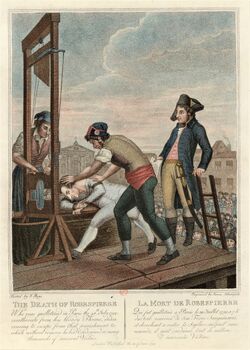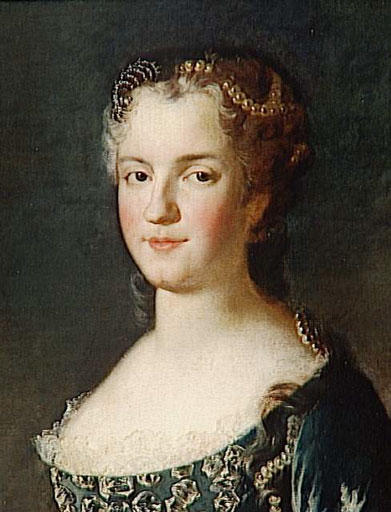The year-long struggle for Louis XVI and Marie Antoinette to have children is well-known; once they did manage to consummate their marriage, Marie Antoinette found herself pregnant fairly frequently. The birth of Marie Thérèse in 1778 was followed by Louis Joseph in 1781, Louis Charles in 1785 and Sophie in 1786.
It is also known that the queen suffered a miscarriage in 1779; however, in 1783 something odd happened. That happened to be the year of the queen's mysteriously discreet pregnancy. Extremely few court sources mention the queen being pregnant in 1783 at all - except for the queen herself.
References to this mysterious pregnancy are found in the intimate correspondance between Marie Antoinette and her brother, Emperor Joseph II. In September 1783, Joseph II wrote to his sister: "I await with infinite impatience ... the news of your pregnancy". On first glance, this might just have been an expression of the emperor's wish to see his sister have another child; yet, the queen herself responded to the letter by informing him that "My pregnancy and health are marvelous" - then ... nothing. None of either Marie Antoinette or Joseph's ensuing letters ever referenced the pregnancy again.
The obvious implication was that the queen miscarried again. In fact, it is widely accepted that the queen did indeed suffer a dramatic miscarriage in November, about the time of her own birthday. The pregnancy had apparently been difficult from the beginning and the ordeal made her health worse for months. However, this does not explain the utter silence of the courtiers on the subject. After all, the pregnancy of a queen was not personal news - it was state business. The fact that Marie Antoinette was apparently certain herself that she was pregnant implies that the pregnancy was established. Consequently, it ought to have been remarked upon by everyone. Yet it was not.
It is generally accepted that the queen's pregnancy was announced in June 1783 which would mean that she was at least three months pregnant by the time of the September letters. Consequently, when she lost the baby in November, she was at least five months along.
| Marie Antoinette in 1783 |
The oddity of the radio silence of the court is the marked oddness of it. Nothing at court was ever truly secret, especially not when it came to the lives of the royals. It has even been suggested that the child was not even Louis XVI's but that of Count Fersen. This, alone, would have made it gold for gossip mongers set on further destroying the queen's reputation. Sadly, that particular story has been repeated by authors such as Evelyn Farr who remains convinced that Marie Antoinette not merely loved Fersen, but had a physical affair with him, too. Farr speculate that the queen had fallen pregnant by Fersen. The theory is extremely doubtful, at best.
There is nothing concrete to suggest that Marie Antoinette and Count Fersen ever developed a physical liaison. On the contrary, throughout her life, the queen had shown marked distaste for adultery and relations outside marriage - even going as far as entirely snubbing Madame du Barry because of her role as royal mistress. While the subject of Marie Antoinette and Fersen deserves its own post, suffice it to say, that the theory lacks credibility of any kind.
Considering that the pregnancy was allegedly a difficult one it is puzzling that no one bothered to mention it. Discretion or consideration of the queen's loss seems unlikely. By this point in time, Marie Antoinette was already the object of remarkably vicious rumours and slander. There is nothing to suggest that everyone at court would suddenly have become gracious enough not to torment her on that head. The fact that no one then suggested that the child was not the king's adds to the unlikeliness of the Evelyn Farr-theory. Her detractors would have given anything to be able to pin such a story on the queen - just imagine the outrage it would cause, if the already deeply unpopular queen was thought to have fallen pregnant by another man! The story would have been too tantalizing to receive so little attention.
As stated, few remarked on the pregnancy. Amongst these was the Marquis de Bombelles who wrote on 29 August 1783:
"There is a worrying silence on the Queen's condition. Many people think that she had a miscarriage last Sunday; and conclude this from the fact that at 11.00, the queen sent for Madame de Polignac, who seemed sad and very worried when she returned..."
This snippet further murks the waters. It suggests that even at the time, the court was eerily silent on the matter, although the fear of a miscarriage in itself ought to have set tongues wagging. Bombelles' statement also confirm that the pregnancy was a difficult one. After all, he wrote the excerpt in late August, when the queen was still pregnant. If it was already suspected that she might have miscarried, it is fair to assume that there were considerable problems with the pregnancy. Furthermore, the queen was said to have been so big at just 4-5 months that doctors already predicted twins. Relying again on Bombelles, he himself reported in October that she queen already looked as if she was at least 6 months pregnant.
Bombelles goes on to comment on the fact that the queen's dame d'honneur, Madame de Chimay, was refused access to her mistress - something that was entirely unheard of as Madame de Chimay - in her capacity as dame d'honneur - had the right to enter the queen's apartment at any time. At any rate, the situation was deeply unusual for the court.
Another aspect must be considered which likely contributed to the aura of mystery of this pregnancy. The queen - and king - had already established a court life in which the monarchs were far more withdrawn from their own court than usual. The couple's love of privacy meant that they retired to their own apartments with a select group of friends whereas hitherto the lives of the monarchs were lived entirely in public. It was noted that Marie Antoinette withdrew even further during her difficult pregnancy. Being thus only surrounded by her entourage, the queen might have felt more comfortable, but to the excluded courtiers, the queen's condition became all the more mysterious. After all, it is far easier to conjure up shadows when kept in the dark.
Miscarrying in itself was - and remains - a deeply personal tragedy. Given Marie Antoinette's pride and determination not to appear weak, it is not unlikely that she consoled herself with her friends over her loss. There might have been nothing mysterious, at all, in the entire affair.
When the queen did miscarry in November, Bombelles is again remarkably well-informed. He felt sure enough of his knowledge to state outright that the miscarriage was luck in disguise, as the fetus was deformed. How would he have known? Unlike the birth of a child (stillborn or living) a miscarriage was not a court event; people were not summoned for it, nor had they the right to witness it. Considering that the miscarriage took place in the middle of the night, Bombelles would not have been anywhere near the queen herself. He cannot have seen the "deformed fetus" for himself. It makes it more likely, then, that he was speculating or repeating rumours he had heard elsewhere.
As for the queen's own silence on the matter - especially in her correspondance with her brother - that has a far more reasonable explanation. The loss of a child in itself was harrowing enough; the situation was only made the worse for the health issues it brought it with. It was not until December 1783 that the queen once again remarked to her brother that her health was good. Interestingly, that same letter reveals her desire to have a second son, but her own assurance that "a few months rest will put me in a better condition to carry it (the pregnancy) through". Clearly the ordeal had been traumatic for both mind and body.
It has been speculated that the queen was remarkably - even unusually - silent about the episode. It can be argued that her behaviour was not different from her typical self. Having a sensitive nature, the queen was not the daughter of Maria Theresia for nothing. Sensitive, yes, but deeply devoted to duty and the image of herself as queen. The latter automatically required her to appear constantly composed - even in the throes of heartache. All in all, it is not unlikely that Marie Antoinette wished to put the episode behind her and focus on the two children she did have.


